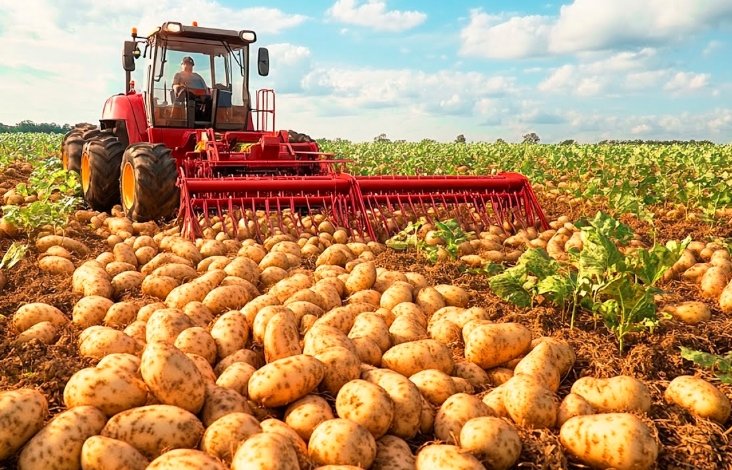Scotland’s potato sector faces tough times from trade blocks and climate shifts, but new tech and global deals offer hope for growth. Growers produce about one million tonnes yearly, supporting farms and jobs across rural areas.
Trade Hurdles Shake Up Exports
Scottish seed potatoes have long been prized for their quality, with strict controls keeping diseases low in the cool climate. Exports hit hard after Brexit cut off EU markets, costing around 11 million pounds each year since 2021.
Growers turned to places like Egypt, which now takes over 50,000 tonnes a year, or 60 percent of total exports. This market runs tight from September to December, packing spuds in hessian sacks on wooden pallets for sea voyages.
Direct deals with Egyptian buyers skipped middlemen, drawing in new farmers with upfront cash and better prices. Yet, planting more of their favored types this year risks too much supply, which could drop prices if demand slips.
Recent talks at the Euroseeds Congress in Edinburgh from October 19 to 22 pushed for UK-EU rules to match on seed trade, aiming to fix delays in potato shipments. A UK-EU meeting on October 21 noted no ban exists on seed potato imports, signaling steps toward reopening doors. Still, legal paperwork lags, leaving no firm start date for EU trade.

Climate Change and Pests Ramp Up Pressure
Warmer summers and odd weather patterns hit potato fields hard this year. A drought in August stressed crops and raised worries over UK food supplies, especially in Scotland.
Potato leafroll virus surged to record levels, up nearly ten times since 2018, thanks to aphids showing up earlier. Before 2020, few plants in Scotland’s 10,000 hectares of seed land carried it, but now experts point to winter aphid survival, spray timing issues, and variety changes as culprits.
Rising costs add to the strain. Fertilizer prices swing wild after global issues, while labor, fuel, and storage energy bills climb. Ware potato farmers feel supermarket price squeezes despite better deals lately.
To fight back, a new guide from experts and industry targets the main potato pest, shared in June. This helps growers spot and handle threats better.
Innovations Boost Resilience and Yields
Scotland leads in plant breeding, with events like the 2025 Euroseeds Congress highlighting new seeds for better crops. Firms like BioPotatoes develop types resistant to blight and viruses, cutting losses from diseases.
Precision tools change the game. Farms use soil sensors, drones, and satellite images to tweak water and fertilizer on the spot, saving money and cutting pollution. Government aid through the Future Farming Investment Scheme makes these tools cheaper.
Trials show biostimulants and smart farming lift seed potato numbers by up to 30 percent. Automation at places like Wellhill Farm speeds up planting and cuts labor needs.
Here are key innovations helping Scottish growers:
- Drone monitoring spots early pest signs, allowing quick sprays to save crops.
- Soil sensors track moisture levels, reducing water waste by 20 percent in dry spells.
- New resistant varieties from local breeding programs fight viruses without heavy chemicals.
- Satellite data helps plan fields for better yields amid changing weather.
The Potatoes in Practice event in August shared these advances with hundreds of sector pros.
Key Markets and Economic Impact
Potatoes fuel Scotland’s rural economy, backing hundreds of farms and linking to UK food chains. From chippies to suppers, they tie into daily life and culture.
Egypt dominates exports, but others like Morocco and the Canary Islands matter too. Losing EU access pushed shifts, with some growers struggling while others thrive in new spots.
| Export Market | Annual Volume (Tonnes) | Share of Total Exports | Main Challenges |
|---|---|---|---|
| Egypt | 50,000 | 60% | Short shipping window, potential oversupply |
| Morocco | 10,000 | 12% | Trade logistics, competition |
| Canary Islands | 8,000 | 10% | Distance, shipping costs |
| Other (pre-Brexit EU) | 15,000 | 18% | Blocked access, ongoing negotiations |
This table shows how reliant the industry is on a few big buyers, highlighting risks if one falters. Total exports hover around 85,000 tonnes yearly, with seed spuds leading for their high value.
Building a Stronger Future Together
Groups like the Seed Potato Organisation unite growers to guard markets and fund research. Closer ties among farmers, processors, and officials shape a national plan for potatoes.
With investments in tech and breeding, Scotland can turn challenges into strengths. The sector’s know-how positions it well for global needs, from healthy food to sustainable farming.
As droughts and viruses test limits, quick action on trade deals could unlock millions in revenue. Potatoes remain a vital crop, blending history with modern promise.
Readers, share your thoughts on how climate change affects local farming or tips for supporting Scottish produce. Comment below and spread the word to keep this important story alive.


















